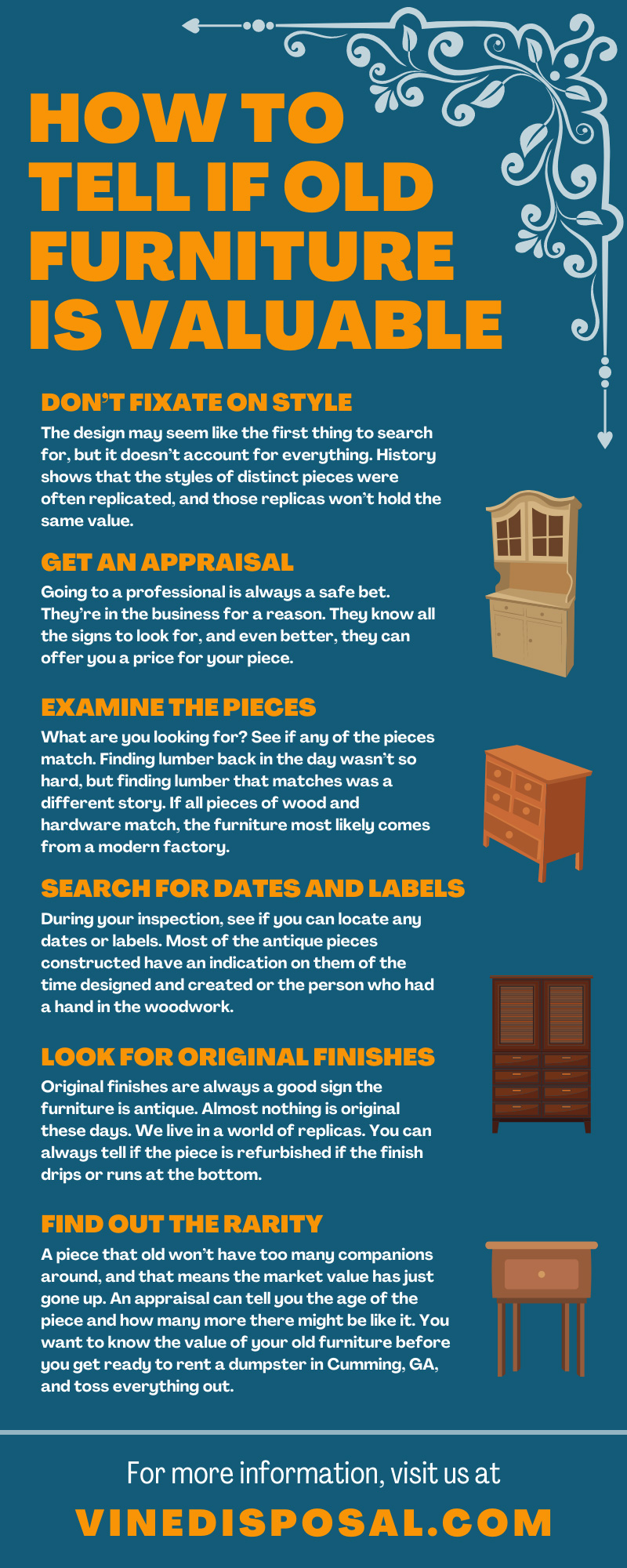
Is Your Furniture Valuable or Just Old? Here’s How to Find Out Before You Toss It
When it comes to old furniture, many people aren’t sure whether it’s valuable or just taking up space. If you’re not an antique collector, it can be hard to know the difference. That’s why we’re here to help!
Before you dive into redesigning your home or clearing out old pieces, it’s important to determine if any of your furniture is worth something. After all, redecorating can get pricey, and knowing the value of your old furniture can help you offset some of those costs. Here’s a quick guide to help you tell if your old furniture has real value.
1. Don’t Just Look at Style
While style is important, it isn’t everything when it comes to determining value. Many furniture styles have been replicated over time, and these replicas often aren’t worth as much as the originals.
For example, finding a Queen Anne chair at a thrift store doesn’t automatically mean you’ve struck gold. Manufacturers regularly recreate and sell these designs, but the value is usually much lower than an authentic piece. Focus on the craftsmanship and other details to determine its true worth.
Some popular styles that have been widely replicated include Queen Anne (1720-1760), Chippendale (1755-1790), and Rocco (1845-1870). Always look beyond the style to find clues about the furniture’s origin.
2. Check the Dovetails
Start by examining the dovetails, which are the wooden joints that hold the furniture together. Don’t confuse these with screws or nails—dovetails are carved directly into the wood.
Older furniture will typically have hand-cut dovetails, which are unique and show slight imperfections from being made by hand. Machine-made dovetails are perfect and identical. If you spot irregularities in the joints, it’s a good sign that your piece is genuine.
3. Get an Appraisal
The best way to know for sure is to consult an expert. Appraisers are trained to spot valuable antiques and can offer a price estimate. However, don’t stop at just one appraisal. Get a few opinions from different collectors to see if the prices vary. This will give you a better sense of the market value.
Once you have a range of prices, you can decide if selling the furniture is a good option or if it’s better to hold onto it.
4. Inspect the Pieces
While checking the dovetails, carefully inspect the entire piece of furniture. Pay attention to the type of wood used. Older furniture often has pieces made from wood that’s harder to find today, and it’s common for different parts to be made from different types of wood.
If the wood types are consistent across the entire piece, it’s more likely to be a mass-produced modern piece. But if you find mismatched wood types, it’s a sign the furniture may be much older.
5. Look for Labels and Dates
Some older furniture pieces may have labels, stamps, or even dates engraved into them. If you find one, it could significantly increase the value of the piece. However, this is rare. Labels from modern furniture manufacturers don’t add value, and any recent dates or markings are a red flag.
Older, authentic furniture will often have worn or warped labels that blend into the wood, showing the piece’s age.
6. Original Finishes Matter
If the furniture still has its original finish, it’s a good sign that it’s an antique. Modern refinishes often leave signs of touch-ups or drips, which can reduce the piece’s value.
While refinishing doesn’t necessarily make a piece worthless, it does affect its value. The more original the finish, the more valuable the piece. However, avoid removing paint to inspect the wood underneath—it will damage the piece and lower its worth.
7. Examine the Screws and Bolts
Believe it or not, screws and bolts can help determine the age of a piece of furniture. Handmade single-slot screws were commonly used in older furniture, and they’re often irregular in shape. Modern screws are usually tapered and uniform.
If the screws are flat with a blunt tip and have irregularities, the piece is likely older and potentially valuable.
8. Consider the Rarity
The rarity of a piece is one of the most significant factors in determining its value. Furniture that’s over 100 years old is less likely to be in good condition, which makes surviving pieces more valuable. Fewer pieces mean higher demand and value.
An appraiser can help you determine the age and rarity of your piece, and knowing its unique characteristics will give you a better idea of its worth.
Need Help Decluttering?
Once you’ve sorted out what’s valuable, the next step is to declutter the items that no longer serve you. That’s where Vine Disposal can help! Whether you’re remodeling or simply clearing out old furniture, we offer convenient dumpster rentals in Cumming, GA, to help you dispose of everything responsibly.
Before you toss anything, make sure you’ve done the research to see if your old furniture holds any hidden value. Let us take care of the clutter while you focus on your next project!
For more information, visit our website or give us a call at 678-315-2193.

